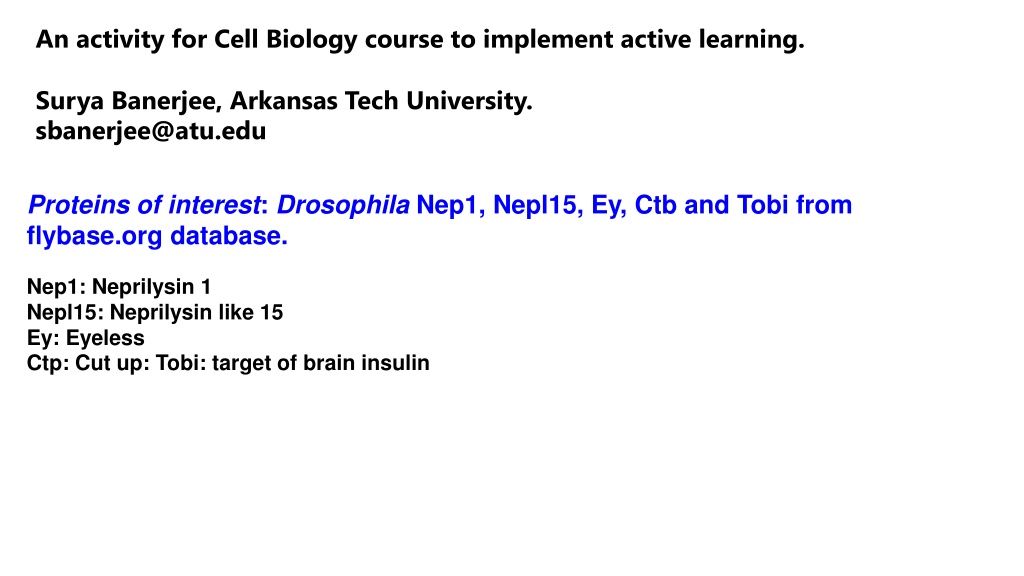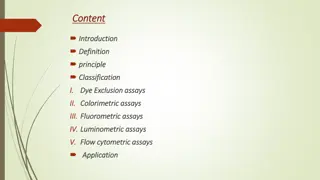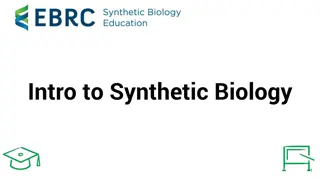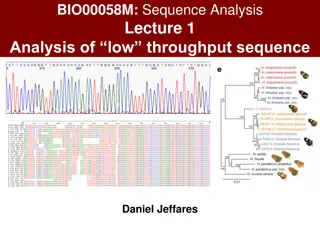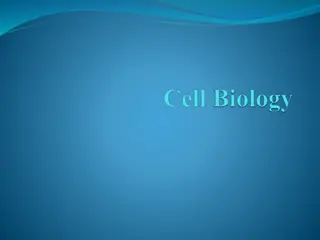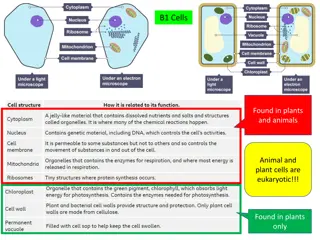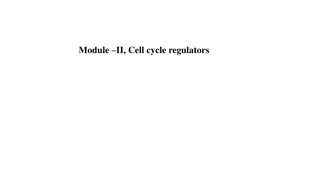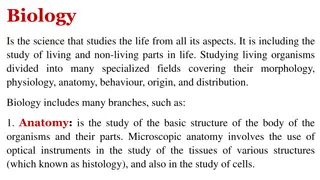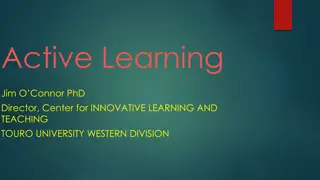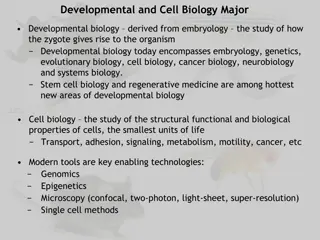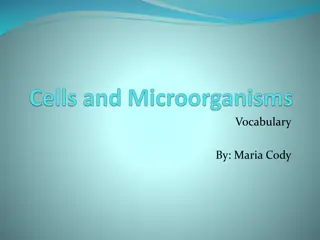Implementing Active Learning in Cell Biology
This activity for a Cell Biology course focuses on proteins of interest from the Drosophila species, such as Nep1, Nepl15, Ey, Ctb, and Tobi. Students engage in analyzing the properties, localization, synthesis, and functions of these proteins. The activity includes analytical questions related to amino acids, protein localization, synthesis pathways, signal sequences, and subcellular functions. Additionally, students access protein sequences through online databases for practical analysis. By actively exploring these topics, students enhance their understanding of cell biology concepts in a hands-on manner.
Download Presentation

Please find below an Image/Link to download the presentation.
The content on the website is provided AS IS for your information and personal use only. It may not be sold, licensed, or shared on other websites without obtaining consent from the author.If you encounter any issues during the download, it is possible that the publisher has removed the file from their server.
You are allowed to download the files provided on this website for personal or commercial use, subject to the condition that they are used lawfully. All files are the property of their respective owners.
The content on the website is provided AS IS for your information and personal use only. It may not be sold, licensed, or shared on other websites without obtaining consent from the author.
E N D
Presentation Transcript
An activity for Cell Biology course to implement active learning. Surya Banerjee, Arkansas Tech University. sbanerjee@atu.edu Proteins of interest: Drosophila Nep1, Nepl15, Ey, Ctb and Tobi from flybase.org database. Nep1: Neprilysin 1 Nepl15: Neprilysin like 15 Ey: Eyeless Ctp: Cut up: Tobi: target of brain insulin
Follow-up analytical questions: 1. What is the first amino acid in the protein and why? 2. What is the predicted localization of the protein? If it is a secreted protein, then where is it cleaved? If it is a cytoplasmic protein, does it enter mitochondria or chloroplast? ? If so, which part of the organelle is likely to reside. 3. Where the protein is likely to be synthesized, in Cytoplasm or RER? If it is synthesized in RER, how the protein is likely to be modified and transported through endomembrane system? 4. Which specific signal sequence(s) the protein is likely to contain? 5. Predict few functions of the protein depending on its subcellular localization.
Nep1: Neprilysin 1 1. go to https://flybase.org/ and insert the gene symbol in the search space, then click search.
2. On the gene page find the sequence tab. 3. Change Gene region with Translations using the dropdown menu and click on Get Sequence.
4. The new page will have protein sequence (single letter sequence) at the bottom in FASTA file format. Select and copy the entire sequence.
FASTA file for Drosophila Nep1 protein MSQQHEATAA AAEKPLNNGY LQANAPLEEL SATVVSPLLG QQQVQHQAPH QMQQQQQQQQ QNKLPTVVFL APDGSGGVGI QRGNPAQGNP GMVTGTGSHS DWLLKESQQR RRLLVLAIAF TVLGAAIGAL AIYFASVHQR CHLYRLEPDN DDRPNGRWNQ DSGSAHEGQD NICMTQECVR TAASLLSAMD LNSDPCEDFF QYACGTWNKM HPIPEDRSSI STFEVLSDQQ QVILRAVLEE PIDERDNKAT IKAKTFFKSC MDIPQIRKIG TGRLKQVLQS LGGWPVIERN WSPPADLSVE RLMGQLRLNY SEPVMIELYV GADDKNSSVN ILQMDQLQYA LPSRDYYLKE SSANDRRAYH RYMTQVALLL GADPATAAAE LEKVVLFETQ LVNVSLPEAD RHDTSLVYRK MLLPELQELV PEVQWQEYLQ AALGPGIPLQ EDEPLVTYGL HYLTEMGKIL AHTDRRVVHN YMLWRLVMSL MSHMIDEYQR ERVEFRKILM GIQSERTRWS QCVEWTNKKL GVAVGALFIR DNFNQESKEV ALEMIHTIRA AFNELLAEND WMDDETRAVA KEKADSMNER IGYPELLTNA TELEQEYVNL TIVPDNFINN VLSILQWESE KMLRLLRQPV DKEKWTTEPA VVNAFYNPNK NDIVFPAGIL QPLFYSQHFP KSLNYGGIGV VIGHEITHGF DDKGRQFDKE GNMMQWWNNA TIEAFRERTQ CVIDQYSRYK INEVDMFMDG RMTQGENIAD NGGLKQAFRA YKKWETLHGR EQQLPGLNMT HDQLFFLNYA QIWCGSMRPE DALTKIRSAV HSPGFVRVLG PLSNSRDFAS AYKCPLGSTM NPAEKCSVW
5. Go to http://www.cbs.dtu.dk/services/DeepLoc-1.0/index.php page and paste the protein sequence. Click Submit and wait.
6. What is the most likely destination of this protein (maximum score for a specific localization)? If this protein is predicted as an extracellular secreted protein, then perform the step 7; or if it is predicted as cytoplasmic protein, then perform the step 8.
7. Go to http://www.cbs.dtu.dk/services/SignalP/ page, paste the protein sequence, select parameters and click submit.
8. Go to http://www.cbs.dtu.dk/services/TargetP/ page, paste the protein sequence, select parameters and click submit.
Proteins of interest: Drosophila Nep1, Nepl15, Ey, Ctb and Tobi from flybase.org database. Outcome from bioinformatics tools and answer to some of the analytical questions: Nep1: Neprilysin 1: Localization: Cell membrane; Synthesized in RER; Contains Signal Peptide. Nepl15: Neprilysin like 15: Localization: Soluble, secreted & extracellular; Synthesized in RER; Contains Signal Peptide and cleavage site between position 22 and 23. Ey: Eyeless: Localization: Nucleus; Synthesized in cytoplasm; Contains Nuclear Localization Signal. Ctp: Cut up: Localization: Cytoplasm soluble; Synthesized in cytoplasm by free ribosom; No such signal. Tobi: target of brain insulin: Localization: RER soluble protein; Synthesized in RER; Contains Signal Peptide that is cleaved. Now, verify with annotated and experimental data from flybase.org and other references.
